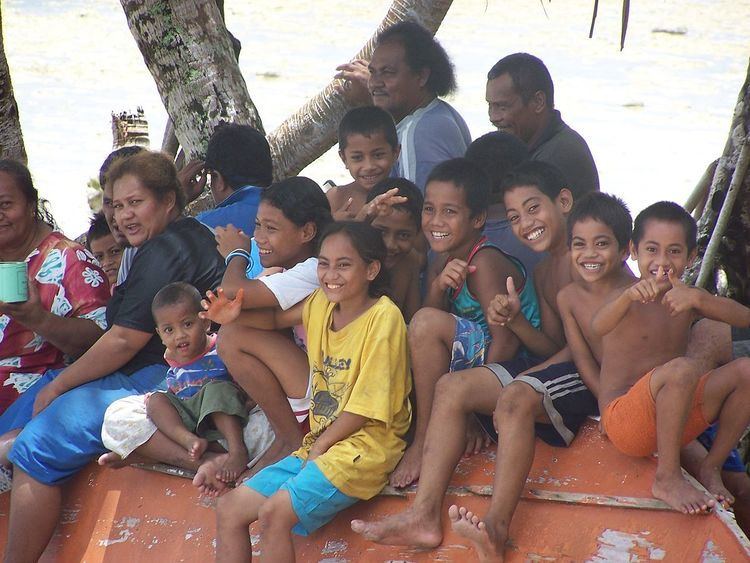This article is about the demographic features of the population of Tuvalu, including the age structure, ethnicity, education level, life expectancy, religious affiliations and other aspects of the population.
The population of Tuvalu is primarily of Polynesian ethnicity with approximately 5.6% of the population being Micronesian. Tuvaluans are ethnically related to the people of Samoa and Tonga. There is evidence for a dual genetic origin of Pacific Islanders in Asia and Melanesia, which results from an analysis of Y chromosome (NRY) and mitochondrial DNA (mtDNA) markers; there is also evidence that Fiji playing a pivotal role in west-to-east expansion within Polynesia.
The vast majority of Tuvaluans belong to the Church of Tuvalu, a Protestant denomination. Their ancestors were converted by Christian missionaries in the 19th century.
School attendance at school is 10 years for males and 11 years for females (2001). Adult literacy rate is 99.0% (2002).
Primary school enrollment (2006): 100 percentSecondary school enrollment (2001): 79.5 percentLife expectancy for women in Tuvalu is 68.41 years and 64.01 years for men (2015 est.).
The population of Tuvalu is recorded by the Central Statistics Department (CSD) of Tuvalu in the census information:
The net migration rate is estimated at -6.81 migrant(s)/1,000 population (2015 est.). The threat of global warming in Tuvalu is not a dominant motivation for migration as Tuvaluans appear to prefer to continue living on the islands for reasons of lifestyle, culture and identity.
The Census Monograph on Migration, Urbanization and Youth provides an analysis of the 2012 census and reported:
A total of 1,200 people were listed as being out of country on census night with more males (57%) than females (43%) absent. The high proportion in range of ages 15 to 29 years (37 percent of the total) is described as indicating the significance of overseas tertiary education and training.The 2013 Census of New Zealand reported 3,537 Tuvaluans, an increase of 80 percent from the 1,965 reported in the 2001 census. In the 2013 census, only about 40 percent (1,419) had been born in Tuvalu. The high proportion of Tuvaluans who are New Zealand born illustrates the significance of New Zealand as a long term destination for Tuvaluan migrants.The Tuvaluan community in Australia is recorded in the 2011 Australian Census as 228 people who put Tuvaluan as their first response to a question on ‘ancestry’; of these 120 were born in Tuvalu.The islands of Nanumea, Nanumaga, Nukufetau and Niutao had relatively high net migration losses, with most being internal migrants to Funafuti. Vaitupu had the largest net migration gain, although this is attributed to the location of Motufoua Secondary School on Vaitupu and the movement of students from the other islands.The following demographic statistics are from the CIA World Factbook, unless otherwise indicated.
98760–14 years: 29.4% (male 1,639/female 1,557)15–24 years: 20.27% (male 1,157/female 1,046)25–54 years: 36.35% (male 1,946/female 2,005)55–64 years: 8.41% (male 373/female 541)65 years and over: 5.57% (male 247/female 358) (2015 est.)Total: 25.2 yearsMale: 24.1 yearsFemale: 26.6 years (2015 est.)0.82%23.74 births/1,000 population8.74 deaths/1,000 population (2015 est.)-6.81 migrant(s)/1,000 population (2015 est.)At birth: 1.05 male(s)/female0–14 years: 1.05 male(s)/female15–24 years: 1.11 male(s)/female25–54 years: 0.97 male(s)/female55–64 years: 0.69 male(s)/female65 years and over: 0.69 male(s)/femaleTotal population: 0.97 male(s)/female (2015 est.)Total: 30.8 deaths/1,000 live birthsMale: 33.46 deaths/1,000 live birthsFemale: 28.01 deaths/1,000 live birthsTotal population: 66.16 yearsMale: 64.01 yearsFemale: 68.41 years3 children born/womanTuvaluan(s) (noun)Tuvaluan (adjective)Polynesian 96%Micronesian 4%Protestant 98.4%Church of Tuvalu (Congregationalist) 97%Seventh-Day Adventist 1.4%)Baha'i 1%Other 0.6%Tuvaluan (official)English (official)SamoanIkiribati language (on the island of Nui)
